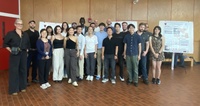Citation:
155., Sean L. Kim, Michael A. Trembley, Keel Yong Lee, Suji Choi, Luke A. MacQueen, John F. Zimmerman, Lousanne H.C. de Wit, Kevin Shani, Douglas E. Henze, Daniel J. Drennan, Shaila A. Saifee, Li Jun Loh, Xujie Liu, Kevin Kit Parker, and William T. Pu. 8/17/2023. “
Spatiotemporal cell junction assembly in human iPSC-CM models of arrhythmogenic cardiomyopathy.” Stem Cell Reports, 18, Pp. 1-16.
Publisher's VersionAbstract:
Arrhythmogenic cardiomyopathy (ACM) is an inherited cardiac disorder that causes life-threatening arrhythmias and myocardial dysfunction. Pathogenic variants in Plakophilin-2 (PKP2), a desmosome component within specialized cardiac cell junctions, cause the majority of ACM cases. However, the molecular mechanisms by which PKP2 variants induce disease phenotypes remain unclear. Here we built bioengineered platforms using genetically modified human induced pluripotent stem cell-derived cardiomyocytes to model the early spatiotemporal process of cardiomyocyte junction assembly in vitro. Heterozygosity for truncating variant PKP2R413X reduced Wnt/β-catenin signaling, impaired myofibrillogenesis, delayed mechanical coupling, and reduced calcium wave velocity in engineered tissues. These abnormalities were ameliorated by SB216763, which activated Wnt/β-catenin signaling, improved cytoskeletal organization, restored cell junction integrity in cell pairs, and improved calcium wave velocity in engineered tissues. Together, these findings highlight the therapeutic potential of modulating Wnt/β-catenin signaling in a human model of ACM.
